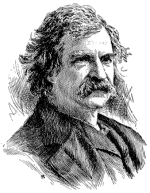The Boys’ Life of Mark Twain
by Paine

LII. European Economies
With Clara and Jean, Mrs. Clemens returned to England, and in a modest house on Tedworth Square, a secluded corner of London, the stricken family hid themselves away for the winter. Few, even of their closest friends, knew of their whereabouts. In time the report was circulated that Mask Twain, old, sick, and deserted by his family, was living in poverty, toiling to pay his debts. Through the London publishers a distant cousin, Dr. James Clemens, of St. Louis, located the house on Tedworth Square, and wrote, offering assistance. He was invited to call, and found a quiet place–the life there simple–but not poverty. By and by there was another report–this time that Mark Twain was dead. A reporter found his way to Tedworth Square, and, being received by Mark Twain himself, asked what he should say.
Clemens regarded him gravely, then, in his slow, nasal drawl, “Say–that the report of my death–has been grossly–exaggerated, “a remark that a day later was amusing both hemispheres. He could not help his humor; it was his natural form of utterance–the medium for conveying fact, fiction, satire, philosophy. Whatever his depth of despair, the quaint surprise of speech would come, and it would be so until his last day.
By November he was at work on his book of travel, which he first thought of calling “Around the World.” He went out not at all that winter, and the work progressed steadily, and was complete by the following May (1897).
Meantime, during his trip around the world, Mark Twain’s publishers had issued two volumes of his work–the “Joan of Arc” book, and another “Tom Sawyer” book, the latter volume combining two rather short stories, “Tom Sawyer Abroad,” published serially in St. Nicholas, and “Tom Sawyer, Detective.” The “Joan of Arc” book, the tenderest and most exquisite of all Mark Twain’s work–a tale told with the deepest sympathy and the rarest delicacy–was dedicated by the author to his wife, as being the only piece of his writing which he considered worthy of this honor. He regarded it as his best book, and this was an opinion that did not change. Twelve years later–it was on his seventy-third birthday–he wrote as his final verdict, November 30, 1908:
“I like the Joan of Arc best of all my books; and it is the best; I
know it perfectly well, and, besides, it furnished me seven times
the pleasure afforded me by any of the others; twelve years of
preparation and two years of writing. The others needed no
preparation and got none.
MARK TWAIN.”
The public at first did not agree with the author’s estimate, and the demand for the book was not large. But the public amended its opinion. The demand for “Joan” increased with each year until its sales ranked with the most popular of Mark Twain’s books.
The new stories of Tom and Huck have never been as popular as the earlier adventures of this pair of heroes. The shorter stories are less important and perhaps less alive, but they are certainly very readable tales, and nobody but Mark Twain could have written them.
Clemens began some new stories when his travel book was out of the way, but presently with the family was on the way to Switzerland for the summer. They lived at Weggis, on Lake Lucerne, in the Villa Buhlegg–a very modest five-franc-a-day pension, for they were economizing and putting away money for the debts. Mark Twain was not in a mood for work, and, besides, proofs of the new book “Following the Equator,” as it is now called–were coming steadily. But on the anniversary of Susy’s death (August 18th) he wrote a poem, “In Memoriam,” in which he touched a literary height never before attained. It was published in “Harper’s Magazine,” and now appears in his collected works.
Across from Villa Buhlegg on the lake-front there was a small shaded inclosure where he loved to sit and look out on the blue water and lofty mountains, one of which, Rigi, he and Twichell had climbed nineteen years before. The little retreat is still there, and to-day one of the trees bears a tablet (in German), “Mark Twain’s Rest.”
Autumn found the family in Vienna, located for the winter at the Hotel Metropole. Mrs. Clemens realized that her daughters must no longer be deprived of social and artistic advantages. For herself, she longed only for retirement.
Vienna is always a gay city, a center of art and culture and splendid social functions. From the moment of his arrival, Mark Twain and his family were in the midst of affairs. Their room at the Metropole became an assembling-place for distinguished members of the several circles that go to make up the dazzling Viennese life. Mrs. Clemens, to her sister in America, once wrote:
“Such funny combinations are here sometimes: one duke, several
counts, several writers, several barons, two princes, newspaper
women, etc.”
Mark Twain found himself the literary lion of the Austrian capital. Every club entertained him and roared with delight at his German speeches. Wherever he appeared on the streets he was recognized.
“Let him pass! Don’t you see it is Herr Mark Twain!” commanded an officer to a guard who, in the midst of a great assemblage, had presumed to bar the way.
 Continue...
Continue...![[Buy at Amazon]](http://images.amazon.com/images/P/B0006AHKG6.01.MZZZZZZZ.jpg)